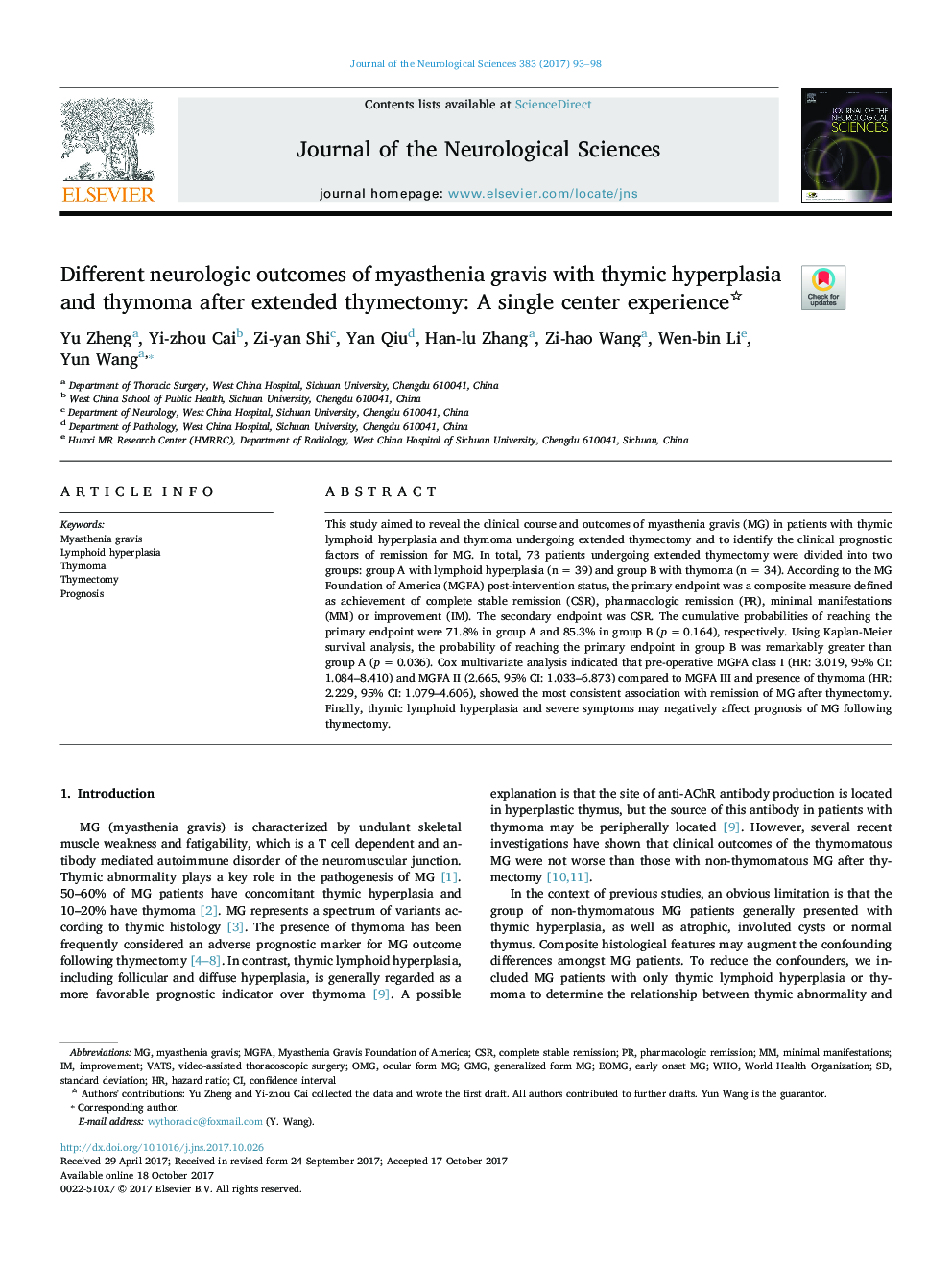| کد مقاله | کد نشریه | سال انتشار | مقاله انگلیسی | نسخه تمام متن |
|---|---|---|---|---|
| 8273162 | 1535078 | 2017 | 6 صفحه PDF | دانلود رایگان |
عنوان انگلیسی مقاله ISI
Different neurologic outcomes of myasthenia gravis with thymic hyperplasia and thymoma after extended thymectomy: A single center experience
ترجمه فارسی عنوان
نتایج مختلف عصب شناختی میاستنی گراویس با هیپرپلازی تومیک و تیموم پس از تجمع پیشرفته: یک تجربه تک مرکز
دانلود مقاله + سفارش ترجمه
دانلود مقاله ISI انگلیسی
رایگان برای ایرانیان
کلمات کلیدی
VATSMGFAGMGEOMGCSROMG - آه خدای منstandard deviation - انحراف معیارImprovement - بهبودThymectomy - تومکتومیThymoma - تیموماVideo-assisted thoracoscopic surgery - جراحی توراکوسکوپی با کمک فیلمWorld Health Organization - سازمان بهداشت جهانیconfidence interval - فاصله اطمینانMyasthenia gravis - میاستنی گراویسhazard ratio - نسبت خطرlymphoid hyperplasia - هیپرپلازی لنفوئیدیprognosis - پیش شناخت بیماریWHO - که
موضوعات مرتبط
علوم زیستی و بیوفناوری
بیوشیمی، ژنتیک و زیست شناسی مولکولی
سالمندی
چکیده انگلیسی
This study aimed to reveal the clinical course and outcomes of myasthenia gravis (MG) in patients with thymic lymphoid hyperplasia and thymoma undergoing extended thymectomy and to identify the clinical prognostic factors of remission for MG. In total, 73 patients undergoing extended thymectomy were divided into two groups: group A with lymphoid hyperplasia (n = 39) and group B with thymoma (n = 34). According to the MG Foundation of America (MGFA) post-intervention status, the primary endpoint was a composite measure defined as achievement of complete stable remission (CSR), pharmacologic remission (PR), minimal manifestations (MM) or improvement (IM). The secondary endpoint was CSR. The cumulative probabilities of reaching the primary endpoint were 71.8% in group A and 85.3% in group B (p = 0.164), respectively. Using Kaplan-Meier survival analysis, the probability of reaching the primary endpoint in group B was remarkably greater than group A (p = 0.036). Cox multivariate analysis indicated that pre-operative MGFA class I (HR: 3.019, 95% CI: 1.084-8.410) and MGFA II (2.665, 95% CI: 1.033-6.873) compared to MGFA III and presence of thymoma (HR: 2.229, 95% CI: 1.079-4.606), showed the most consistent association with remission of MG after thymectomy. Finally, thymic lymphoid hyperplasia and severe symptoms may negatively affect prognosis of MG following thymectomy.
ناشر
Database: Elsevier - ScienceDirect (ساینس دایرکت)
Journal: Journal of the Neurological Sciences - Volume 383, 15 December 2017, Pages 93-98
Journal: Journal of the Neurological Sciences - Volume 383, 15 December 2017, Pages 93-98
نویسندگان
Yu Zheng, Yi-zhou Cai, Zi-yan Shi, Yan Qiu, Han-lu Zhang, Zi-hao Wang, Wen-bin Li, Yun Wang,
